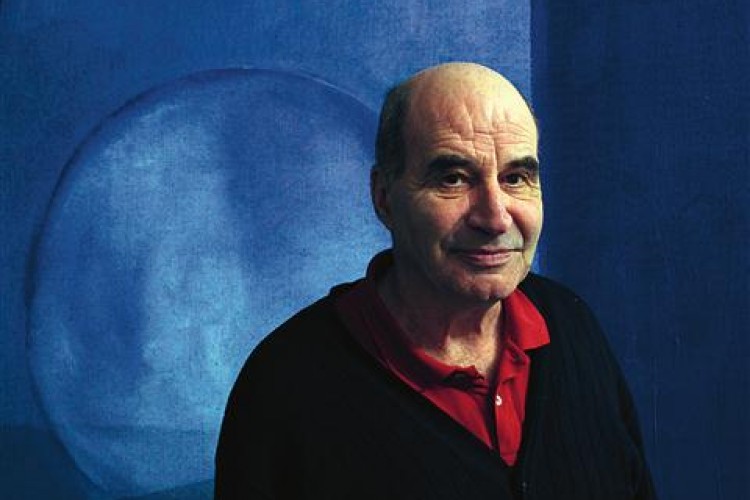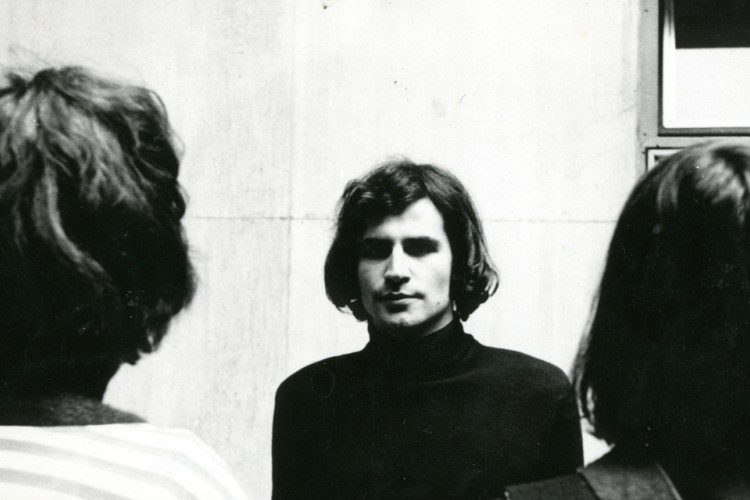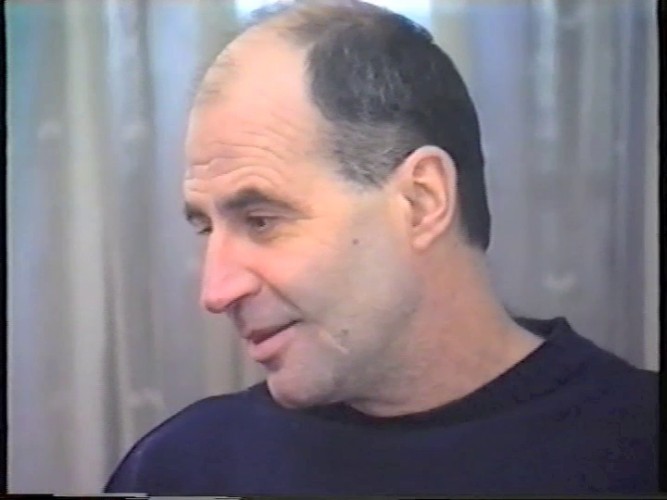Born in Ljubljana on 30 July 1947, Andraž Šalamun finished high school in Koper. Following that he first went to study atomic physics at the University of Ljubljana, but found that he was not well suited to the subject, so he changed his major to comparative literature and philosophy. In Ljubljana he lived at Gradišče 10. Between 1966 and 1971 he was a member of the conceptual movement/group OHO, which was connected with the lively movement of the so-called new artistic practices in Belgrade, Novi Sad, and Zagreb. Šalamun took part in happenings and produced objects and installations. He described this period as a time of good collaboration and collective exhibiting, despite the fact that the group was composed of individualists. Independently, he participated in the first production of the experimental theater Glej in Ljubljana in 1970 with his design for the set of Peter Handke's Caspar (according to the artist, he was fascinated by set design, but did not have the opportunity to pursue his interest later on in Koper). When the OHO group ceased to exist as an art group, he did not join its next stage, i.e. the Šempas Family. By then, Šalamun found conceptualism dead. In 1975 he completed his studies – "for the sake of my inner peace" – and returned to Koper. Since then he has lived in Koper at Ulica Agrarne reforme 15.
Šalamun has had the status of a freelance artist since 1977. That same year he received a prestigious Yugoslav award for young artists, the Seven Secretaries of SKOJ* for his painting. In the 1980s he won several prizes and awards at various art events across Yugoslavia (Pazin, Sombor, Dubrovnik, Sisak, Čačak). In 1993 he received one of the highest awards for culture in Slovenia, the Prešeren Foundation Award. His name is also listed among the winners of the third Rembrandt Gold Coin in 1994, which was the last year the new art award was given in the new state.
Šalamun was among the younger-generation artists who actively tried to create better opportunities for presenting their work, which resulted in establishing the Artists' Permanent Work Community Equrna in Ljubljana in 1982. The same year saw the formation of the Association of Artists of the Slovene Coast (DLUSO), later renamed Insula in Primorska, where Šalamun has been a member since the beginning. The Coastal Galleries have been operating as a single institution (with its head office in Piran) since 1974. From 1977, Andrej Medved, one of the leading reviewers of and writers on Šalamun's work, worked there as curator. Medved also graduated from Ljubljana University in 1975 (with a degree in philosophy and art history).
In his early years in Koper, Šalamun traveled a lot, looking for new creative approaches. On one of his trips he met painter Bojan Bem, which had a profound effect on him. Between 1971 and 1976 he made a series of pastels and drawings called Coasts. The artist actually puts a date on the beginning of his career as a painter: 7 March 1976. His first paintings were large-scale works done in the manner of action painting: he would lay the support on the ground and apply paints, pigments, and materials. He also used mortar and, thanks to painter France Gruden and his particular approach, discovered acrylic paints. Writing about the Genius loci exhibition in Equrna in 1986, Tomaž Brejc said that painters at the exhibition modeled their works on photographs. The 1980s were marked by a series of large animal pictures – in an interview the artist spoke about incidentally discovering the image of bison. Over the decade, Šalamun participated in numerous art events across Yugoslavia, organized in a very different spirit than the one prevalent in the federal state, which was beginning to come apart at the seams. The first series in the 1990s was Suns. lt was followed by a series of oblong paintings entitled Moss and Silver, which title was taken from a poem by the late poet Jure Detela (Šalamun's sister, Katarina Šalamun-Biedrzycka, chose the same title for her anthology of Slovene poetry translated into Polish, (Mah in srebro – Srebro i mech. Antologia poezji słoweńskiej), and then by the series of large diptychs of Greek islands. After a short period of female nudes, Andraž Šalamun started the new millennium with new landscapes described as sublime or as "psychic landscape." Since 1998 he has been working with Studio Sqart from Koper and its manager Janez Matelič; for the studio, Šalamun produces prints of smaller formats than his paintings. He still finds traveling very important as a source of information and because, as he says, "nomadism is a form of freedom."
Critics describe his art as free and spontaneous; he has also spoken about the ritual aspects of his work method. Some of the phrases characterizing his images are "chaotic syndrome," "sensuous manifestation," "hedonistic play" - archetypes denoting the ambivalence of the artist's early experience of conceptual art. Pojmovnik slovenske umetnosti po letu 1945 (Glossary of Slovene Art Since 1945; Ljubljana, 2009) mentions Andraž Šalamun in relation to nine entries: conceptualism – body art – land art – performance – OHO – New Image – abstract colorism – fundamental painting – regionalism.
Šalamun has exhibited widely, along two separate lines: as part of the group OHO he has been featured in major global surveys of conceptual art, while his paintings were included (soon after his first solo presentations in Belgrade and Zagreb) in the Yugoslav sections of major world exhibitions (the Sao Paulo Biennial in 1979, the Venice Biennale in 1982), in the collections of Yugoslav museums and galleries and in traveling survey exhibitions of (young) Slovene art. In addition, his work is often featured in regional exhibitions. He has also tried to succeed commercially as a painter, but according to the artist, was not ready to submit to the pressures of gallerists and so abandoned the practice. In addition, the Coastal Galleries and Equrna, both of which had presented his work at fairs in Bologna, BaseI, Madrid, and Los Angeles, soon stopped exhibiting at art fairs.
Looking over the writings on Šalamun and his art, one can't help but notice the artist's close relationship with three key art historians and critics of his generation; in addition to the above-mentioned Andrej Medved are Tomaž Brejc, an associate of both the OHO group and Equrna, and Ješa Denegri from Belgrade, who followed and promoted the artist from the time of the OHO group.**
* League of Communist Youth of Yugoslavia
** The biography is compiled from data available in exhibition catalogues, articles in the press, and the artist's statements, which are listed in a special segment of the literature section [of the catalogue].





